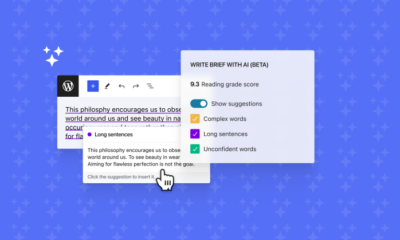MARKETING
How to Write a Memo [Template & Examples]
![How to Write a Memo [Template & Examples] How to Write a Memo [Template & Examples]](https://articles.entireweb.com/wp-content/uploads/2022/11/How-to-Write-a-Memo-Template-Examples.jpgkeepProtocol.jpeg)
A memo (also known as a memorandum, or “reminder”) is used for internal communications regarding procedures or official business within an organization.
Unlike an email, a memo is a message you send to a large group of employees, like your entire department or everyone at the company. You might need to write a memo to inform staff of upcoming events or broadcast internal changes.
If you need to inform your employees of official internal business, we’ll show you how to write a memo to better communicate your message. But before we break it down, let’s talk about the many purposes of memos.
What is a memorandum?
A memorandum, or memo, is a document shared with a group of people to disperse information on a task, project, event, or other. The purpose of a memo is to bring immediate attention to that information in a quick and brief manner.
Memorandums are shared to inform readers about new information and have applications for different communities and businesses.
Communities can use memos to tell people within it about public safety guidelines, promote various events, raise awareness on subjects that affect their lives.
Businesses can use memos to relay information involving newly updated policy, changes in procedure, or persuade employees to take an action, such as attend an upcoming meeting, convention, or a celebration for organizational milestones.
Next, we’ll walk you through writing a memo of your own.
How to Write a Memo
- Write a heading.
- Write an introduction.
- Provide background on the issue
- Outline action items and timeline.
- Include a closing statement.
- Review and proofread before sending.
You can put together a memo in a few short steps. All memos should include the following:
1. Write a heading.
No matter what kind of memo you’re writing, you’ll need to include a heading. This section should include who the memo is for (whether an individual or department), the date, who the memo is from, and a subject line.
Your subject line should be, short, attention-grabbing, and give readers a general idea of what the memo is about.
2. Write an introduction.
Your introduction should summarize the purpose of your memo in two to three sentences. It should highlight the issue or problem and the solution you decided to move forward with.
3. Provide background on the issue.
In this section, explain the reasoning behind the memo. For example, it could be changes in the budget, a company restructuring, or a new rollout of procedures. This explanation should provide justification for the changes being implemented.
![How to Write a Memo [Template & Examples] How to write a memo infographic with steps](https://articles.entireweb.com/wp-content/uploads/2022/11/1668769513_467_How-to-Write-a-Memo-Template-Examples.jpg)
4. Outline action items and timeline (Optional).
Depending on the purpose of your memo, you may have action items for employees to complete or provide a timeline of when changes will take place. For example, they may need to complete a task or provide information by a certain deadline. This section should include the following:
- When employees can expect changes to go into effect
- What changes have already been made and what to expect in the future
- Deadlines they need to adhere to
If no action is needed on the employee’s behalf, you can leave this section out.
5. Include a closing statement.
Your closing statement will include any information you’d like to reinforce. Are there any specific contacts readers should reach out to for questions? If so, include them here.
6. Review and proofread before sending.
This step may seem like a no-brainer but it’s important to review your document before sending it out. Memos are meant to inform readers of upcoming changes and relay important information. You don’t want to risk causing confusion with a typo or misstatement.
To begin making your own business memos, here’s an easy-to-follow business memo template with examples of how to use them to serve different needs as guidance.
Business Memo Template
MEMORANDUM
TO:
FROM:
DATE:
SUBJECT:
I’m writing to inform you that [reason for writing memo].
As our company continues to grow … [evidence or reason to support your opening paragraph].
Please let me know if you have any questions. In the meantime, I’d appreciate your cooperation as [official business information] takes place.
Business Memo Template Format
The business memo template format is designed to effectively communicate your message. A memo should disseminate the necessary information in a way that is easy for a mass number of employees to digest.
An accurate subject line will alert them that this memo is relevant to them specifically. And beginning with an executive summary allows recipients to understand the general message before they dive deeper into the details. The background information offers context to the message, and the overview and timeline should answer questions that are likely to come up.
Header:
In your header, you’ll want to clearly label your content “Memorandum” so your readers know exactly what they’re receiving. As previously mentioned, you’ll want to include “TO”, “FROM”, “DATE”, and “SUBJECT”. This information is relevant for providing content, like who you’re addressing, and why.
Paragraph One:
In the first paragraph, you’ll want to quickly and clearly state the purpose of your memo. You might begin your sentence with the phrase, “I’m writing to inform you … ” or “I’m writing to request … “. A memo is meant to be short, clear, and to the point. You’ll want to deliver your most critical information upfront, and then use subsequent paragraphs as opportunities to dive into more detail.
Paragraph Two:
In the second paragraph, you’ll want to provide context or supporting evidence. For instance, let’s say your memo is informing the company of an internal re-organization. If this is the case, paragraph two should say something like, “As our company continues to grow, we’ve decided it makes more sense to separate our video production team from our content team. This way, those teams can focus more on their individual goals.”
Paragraph Three:
In the third paragraph, you’ll want to include your specific request of each employee — if you’re planning a team outing, this is the space you’d include, “Please RSVP with dietary restrictions,” or “Please email me with questions.”
On the contrary, if you’re informing staff of upcoming construction to the building, you might say, “I’d appreciate your cooperation during this time.” Even if there isn’t any specific action you expect from employees, it’s helpful to include how you hope they’ll handle the news and whether you expect them to do something in response to the memo.
Downloadable Memo Template
Want to see the above memo format in its final form? Download HubSpot’s free business memo templates, shown below. The document gives you a framework that sorts your memorandum into subtopics to help employees better digest the information and understand what’s expected of them after reading it.
Memo Examples
Different industries or situations will require slightly different memos. Certain ones will need to be longer or shorter, others may not have a timeline, and some will have extensive background information. The format of your memo should change to fit the message you want your employees to receive.
Launch Delay Memo
![How to Write a Memo [Template & Examples] Business memo example for launch delay](https://articles.entireweb.com/wp-content/uploads/2022/11/1668769514_964_How-to-Write-a-Memo-Template-Examples.png)
The objective of this memo is to announce that the launch of a product will be delayed. The introduction includes the new date, so a timeline or long overview isn’t necessary. This format of this memo could be applied to other situations where a simple, but important, change is occurring.
What We Like: The launch memo provides readers with insight behind product launch delays, which can alleviate some frustration that customers or employees may otherwise feel if they were not informed.
Other date changes, promotions, milestones, or product announcements could also utilize this format.
Building Update Memo
![How to Write a Memo [Template & Examples] Business memo example for building update](https://articles.entireweb.com/wp-content/uploads/2022/11/1668769514_361_How-to-Write-a-Memo-Template-Examples.png)
There are logistical aspects of a business that concern your employees, but don’t necessarily involve their work. This memo depicts an example of a kitchen remodel in the office. It’s a bit of an inconvenience but not one of a large magnitude.
What We Like: This memo demonstrates a business’s understanding of the impact that renovations can have on employees and shows respect and consideration for their needs.
This memo format could be applied to other building updates, work-from-home days, or other widespread but minor announcements.
Community Memo
![How to Write a Memo [Template & Examples] Business memo example for community announcement](https://articles.entireweb.com/wp-content/uploads/2022/11/1668769514_434_How-to-Write-a-Memo-Template-Examples.png)
Celebrations, events, theme days, or other fun things for your employees can also be communicated through memos. Community memos like this example are generally shorter because they don’t require much background information or many details.
What We Like: This memo has clear directions on where to find the event taking place, something which would’ve been less effective if it only would’ve included the floor number.
Memos of this nature should include a summary, date, and location at minimum.
Persuasion Memo
![How to Write a Memo [Template & Examples] business memo example for persuasion memo](https://articles.entireweb.com/wp-content/uploads/2022/11/1668769514_446_How-to-Write-a-Memo-Template-Examples.png)
Persuasion memos are used to encourage readers to take action regarding an event or proposition, like voting or petitioning.
What We Like: This persuasion memo prioritizes giving the reader information to learn on their own and make a decision based on their findings.
The main components of the persuasion memo should include an overview of the task at hand, context to learn more about it, and a call to action that emphasizes the impact the reader can potentially make.
Write Your Memos To the Point
The main difference between a memo and just an email is not the level of complexity, it’s the size of the audience. A memo can be simple or intricate, as long as it effectively communicates your message and is relevant to the receiving group of employees. And the message itself should be clear and concise, no matter which memo format you use.
Editor’s note: This post was originally published in October 2018 and has been updated for comprehensiveness.

![How to Write a Memo [Template & Examples] → Download Now: 4 Free Memo Templates [Free Resource]](https://articles.entireweb.com/wp-content/uploads/2022/11/How-to-Write-a-Memo-Template-Examples.png)
![How to Write a Memo [Template & Examples] Memo template](https://articles.entireweb.com/wp-content/uploads/2022/11/1668769513_791_How-to-Write-a-Memo-Template-Examples.png)
![How to Write a Memo [Template & Examples] New call-to-action](https://articles.entireweb.com/wp-content/uploads/2022/11/1668769514_710_How-to-Write-a-Memo-Template-Examples.png)


















You must be logged in to post a comment Login